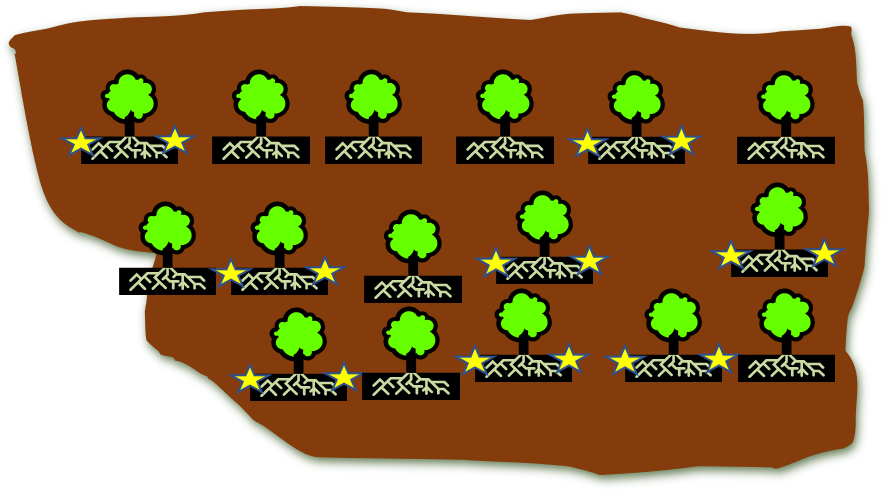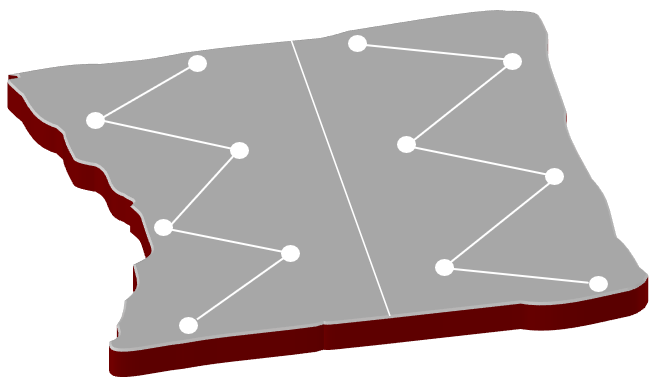Soil Testing
At RAL Labs we focus on real time analysis of soil, water and tissue.
Every soil sample we analyse is extracted for nutrients with a customized extractant suited and catered to the pH of the soil sample.
We analyse Physical, Chemical, Biological & Biochemical Parameters of Soils.
Soil Testing
At our laboratory we focus on real time analysis of soil, water and tissue analysis.
Every soil sample we analyse is extracted for nutrients with a customized extractant suited and catered to the pH of the soil sample.
We analyse Physical, Chemical, Biological & Biochemical Parameters of Soil
Please call us at 0821-2974333 for a detailed technical explanation of the analysis.
Indiscriminate use of water without taking into account the crop requirements and soil capacity, imbalance in fertilizer application and adoption of single nutrient therapy over the years has resulted in:
✅ Problematic & Infertile Soils
✅ Reduced Soil Productivity Index (SPI)
✅ Reduced Nutrient Use Efficiency (NUE)
Which further leads to:
✅ Increased application of fertilisers
✅ Increased cost of cultivation
✅ Low yields with impaired quality.
Hence it is critical to bridge the gap between what our soil status is and what crops require, so as to optimise the production level and to minimize the overall cost of production.
Prognostic soil and tissue analysis is an excellent analytical tool that can be called upon to maintain the Soil and Crop continuum.
Please Note:
Analysis Data obtained from RAL/IMT methods of analysis cannot be compared to the data obtained from conventional methods of analysis. At RAL/IMT Labs we use a customised pH adjusted method of analysis.
Soil Rectification Parameters-
pH, Ec, Texture,
CaCO3 % in Alkaline Soils & Aluminium in Acidic soils only.
Basic Cations (Secondary Nutrients)-Potassium, Calcium, Magnesium,
CEC, Percentage Base Saturation
Sodium & Salinity status of soil.
Nutrient Status of Soil:
Macronutrients- Nitrogen, Phosphorus, Potassium
Micronutrients- Iron, Manganese, Zinc, Copper, Boron, MOLYBDENUM
Sulphur, Chloride
Organic Matter, Water Holding Capacity,
Field Capacity
Soil Rectification Parameters-
pH, Ec, Texture,
CaCO3 % in Alkaline Soils & Aluminium in Acidic soils only.
Basic Cations (Secondary Nutrients)-Potassium, Calcium, Magnesium,
CEC, Percentage Base Saturation
Sodium & Salinity status of soil.
Nutrient Status of Soil:
Macronutrients- Nitrogen, Phosphorus, Potassium
Micronutrients- Iron, Manganese, Zinc, Copper, Boron, MOLYBDENUM
Sulphur, Chloride
Organic Matter, Water Holding Capacity,
Field Capacity
Microbiological Parameters:
Beneficial microbes– Total Bacterial Count, Total Fungal Count, Actinomycetes, Free living Diazotrophs, Phosphorus Solubilising Microbes, Trichoderma
Non-beneficial/pathogenic microbes: Salmonella, Coliforms and others.
Biochemical Parameters:
Urease: Indicator of N-mineralization
Phosphatase: Indicator of Phosphorus recycling
Total Microbial Activity (FDA Analysis): Indicator of Carbon Cycling
Catalase– indicator of soil fertility and oxidative stress
Soil Respiration– Indicator of aerobic respiration in soils.
Soil Antibiotic Resistance: Antibiotics are highly effective, bioactive substances. They contaminate the soil mostly via excrements and animal manure. When pathogens are resistant or acquire resistance via gene transfer, humans and animals are endangered to suffer from infections that cannot be treated with pharmacotherapy. HEALTHIER/CLEANER SOILS HAVE LOWER ANTIBIOTIC RESISTANCE.
SOIL SAMPLING PROCEDURE
- Sampling is the most important step in any analysis. Only a representative sample will give us a representative holistic picture of the soil. Hence focus should be given to this step. See image for clarification.
- Monocrop/ Single Season Crop: One representative sample is suggested every 5-6 acres.
- Perennial: Samples have to be taken from the drip zone/ fetiliser application area around 3-4 feet away from the trunk of the trees.
- Samples have to be taken from 15-20 locations randomly, going in zigzag motion, 3-4 days after irrigation so that sample is sent to lab in semi-wet condition.
- Samples have to be taken at a depth of 4-6” which is devoid of stubble, crop residues and any other bigger objects.
Sample should be labelled with all the following details.
- Name of the farmer
- Complete Address-including Taluka and District
- E-mail ID
- Telephone number
- Crop of interest
> How much sample should be collected
The minimum quantity of the sample to be sent for analysis should be 1kg.
> How to pack the sample
The bag should be only ¾ filled to allow some air movement in the bag.
Do not use fertilizer or pesticide bags for sample collection.
TESTS
Overview
Indiscriminate use of water (without taking into account the crop requirements and soil capacity), imbalance in fertilizer application and adoption of single nutrient therapy over the years has resulted in:
✅ Problematic & Infertile Soils
✅ Reduced Soil Productivity Index (SPI)
✅ Reduced Nutrient Use Efficiency (NUE)
Which further leads to:
✅ Increased application of fertilizers
✅ Increased cost of cultivation
✅ Low yields with impaired quality.
Hence, it is critical to bridge the gap between our soil status and what crops require to optimise the production level and minimize the overall cost of production.
Prognostic soil and tissue analysis is an excellent analytical tool that can be called upon to maintain the Soil and Crop continuum.
PLEASE NOTE:
Analysis Data obtained from RAL/IMT methods of analysis cannot be compared to the data obtained from conventional methods of analysis. At RAL/IMT Labs we use a customised pH adjusted method of analysis.
Test Name
S1 – SOIL RECTIFICATION ANALYSIS
Test Name
S2 – SOIL RECTIFICATION PARAMETERS + NUTRIENT STATUS OF SOIL
Test Parameters
pH, Ec, Texture,
CaCO3 % (Alkaline Soils)/ Aluminium (Acidic soils)
Sodium, Potassium, Calcium, Magnesium,
CEC, Percentage Base Saturation
Sodium status of soil.
+
Iron, Manganese, Zinc, Copper Phosphorous, Magnesium.
Rs. 1000/- sample
(Prices subject to change without prior intimation)
Test Name
S3- SOIL RECTIFICATION PARAMETERS (S1) + NUTRIENT STATUS OF SOIL (S2) + CROP PRODUCTIVITY PARAMETERS.
Test Parameters
pH, Ec, Texture,
CaCO3 % (Alkaline Soils only)/ Aluminium (Acidic soils only)
Sodium, Potassium, Calcium, Magnesium,
CEC, Percentage Base Saturation
Sodium status of soil.
+
Iron, Manganese, Zinc, Copper
Phosphorous, Magnesium.
+
Nitrogen, Sulphur
Boron, Molybdenum (Acidic soils only), Chloride
Organic Matter, Water Holding Capacity,
Field Capacity only
Rs. 1500/- sample
(Prices subject to change without prior intimation)
Test Name
S4- SOIL AUDIT- Soil Rectification (S1) + Nutrient Status (S2) + Crop Productivity Parameters (S3) + Soil Microbiology + Soil Biochemistry
Test Parameters
pH, Ec, Texture,
CaCO3 % (Alkaline Soils)/ Aluminium (Acidic soils)
Sodium, Potassium, Calcium, Magnesium,
CEC, Percentage Base Saturation
Sodium status of soil.
+
Iron, Manganese, Zinc, Copper
Phosphorous, Magnesium.
+
Nitrogen, Sulphur
Boron, Molybdenum, Chloride
Organic Matter, Water Holding Capacity, Field Capacity +
+
Microbiological Parameters:
Total Bacterial Count, Total Fungal Count, Actinomycetes, N2 fixing bacteria,
Phosphorus Solubilising Microbes, Potassium Solubilising Microbes and Zinc Solubilising Microbes
+
Proteobacteria : Salmonella, Pseudomonas, E. coli
Biochemical Parameters:
Urease: Indicator of N-mineralization
Phosphatase: Indicator of Phosphorus recycling
Total Microbial Activity (FDA Analysis): Indicator of Carbon Cycling
Rs. 2500/- sample
(Prices subject to change without prior intimation)
Test Name
S5: Soil Health Index Parameters
Test Parameters
pH, Ec, Texture, Aeration, Water Holding Capacity, Field Capacity
Chemical Parameters:
Ca, Mg, Al, H,CO3, HCO3, CEC, Ca:Mg, Ca:Al & Heavy Metals.
Biological Parameters:
Beneficial Microbes, TBC, TFC, NF, Actinomycetes Enteric/ Salmonids Microbial Population.
Biochemical Parameters:
FDA, Nitrogenase, Phosphatase.
Rs. 4500/- sample
(Prices subject to change without prior intimation)
SOIL SAMPLING PROCEDURE
- Sampling is the most important step in any analysis. Only a representative sample will give us a representative holistic picture of the soil. Hence focus should be given to this step. See image for clarification.
- Monocrop/ Single Season Crop: One representative sample is suggested per 8-10 acres.
- Perennial: Samples have to be taken from the rhizosphere area around 3-4 feet away from the trunk of the trees.
- Samples have to be taken from 15-20 locations randomly, going in zigzag motion, 3-4 days after irrigation so that sample is sent to lab in semi-wet condition.
- Samples have to be taken at a depth of 4-6” which is devoid of stubble, crop residues and any other bigger objects.
Sampling for Perennial/ Horticultural Crops like Banana, Citrus, Coffee, Mango, Grapes, Pomegranate (Random Sampling)

Sampling for Annual/Seasonal Crops like High Value Vegetables (Tomato, Chilly, Capsicum, and Onion), Cash Crops (Cotton, Sugarcane, and Turmeric/Ginger), and Cereals.

Sampling for Perennial/ Horticultural Crops like Banana, Citrus, Coffee, Mango, Grapes, Pomegranate (Random Sampling)

Sampling for Annual/Seasonal Crops like High Value Vegetables (Tomato, Chilly, Capsicum, and Onion), Cash Crops (Cotton, Sugarcane, and Turmeric/Ginger), and Cereals.

Sample should be labelled with all the following details.
- Name of the farmer
- Complete Address-including Taluka and District
- E-mail ID
- Telephone number
- Crop of interest
- Fertilizers applied with quantity and Irrigation method.
